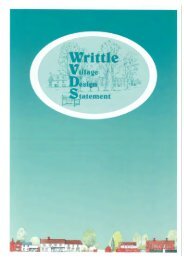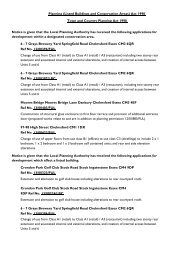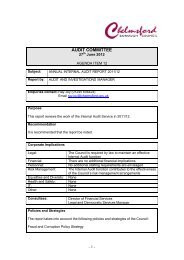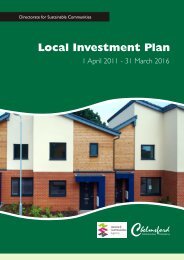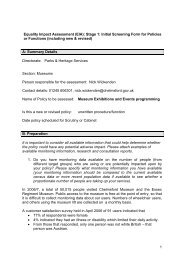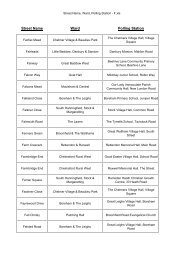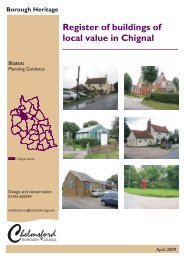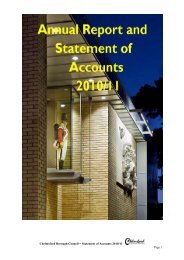16and have been found to have been either enclosed by small fairly shallow ditchers ofunenclosed. In addition the site excavated at Boreham Interchange contained small post-builtstructures, which appear to have been shrines.2.3.5 In addition to the evidence of bronze casting at Springfield Lyons, finds of Bronze Agemetalwork are widespread throughout the region. The raw materials for this all had to beimported, and the river valleys and estuaries, were crucial routes. Fenn Creek and the CrouchEstuary, which by this stage was fully tidal, provide evidence of the economic importance ofestuarine areas; the earliest saltern in Essex, of later Bronze Age date has been recorded here.Salt would have played a vital role as flavouring, preservative and valuable commodity fortrade.2.3.6 The Iron Age (800 BC – AD 45) brought an increased focus to settlement as the first ‘towns’or ‘Oppida’ began to develop. Hillforts, such as that established at Danbury whichcommands wide views to the south across the Crouch valley towards the distant Thames,were also an iconic monument of the time. In general there is more Iron Age settlementevidence from the boulder clay areas than other areas within the region. Rectilinear fields ofIron Age/Romano-British date exist within the landscape. Towards the end of the Iron Agecoinage was first introduced into Britain and recently a number of Iron Age gold coin hoardshave been recovered.2.3.7 Examples of prehistoric sites in this area include: Slight univallate hillfort, in Brentwood, dating between the late Bronze Age and early IronAge, at the crest of a ridge of sands. Ring Hill Camp in the parish of Littlebury, Uttlesford. An oval hillfort on a summit of thehill overlooking the River Cam.2.3.8 Roman settlement (c.43 to 410 AD) was generally built along the Roman roads from thecoast and into Colchester, or other economic centres. In addition to Colchester other smalltowns or significant settlements include <strong>Chelmsford</strong>, Heybridge, Wickford, Braintree andGreat Dunmow. Forts within the region may have been established after AD60 in theaftermath of the Boudican rebellion. The rural hinterland was densely settled, with some IronAge settlements being formalised, such as at Little Waltham. Villas, bathhouses, Temples,administrative centres and also supporting farming systems have all been recorded within theregion. Environmental evidence recovered from alluvium and peat in the intertidal zone ofthe Crouch estuary near Fenn Creek has also revealed largely freshwater sedimentationperhaps the result of constriction of the tidal flow by bridges at Hullbridge and/or Fambridge.2.3.9 Examples of Roman sites in the area include: Roman barrow, in the Parish of Elmdon Langley, Uttlesford. Circular in plan and 50m indiameter. Ploughing over the years has reduced the mound, but there is still a significantamount left to make it a prominent landmark. Roman Villa, in Rivenhall, Braintree. This site comprises of the remains of at least fourmajor Roman building and associated characteristics including Roman burials that havebeen built on a previous Iron Age settlement.2.3.10 As the Saxons settled in the Study Area they reused earlier settlements but also created newones. Settlement also tends to lie around, but at a distance from, the former Roman towns,which is probably not an accident. It seems to be an acknowledgement of the strategicimportance of river confluences and the significance of the former Roman town, togetherwith a desire to keep at a distance from them. Pollen evidence from peat deposits recorded inthe valley of the Chelmer and Sandon Brook in advance of construction of the A12 bypass,Section 2.0 – Overview of the Study Area11100101R Final LCAs_09-06
17showed continuous cereal production from the Iron Age throughout the Roman period andinto the Saxon period.2.3.11 The principal towns of the Study Area were market towns by the Domesday Book (1086).They each had their own church, and in Maldon and Uttlesford there were several. In around1100, the Bishops of London built a new bridge at <strong>Chelmsford</strong> which stimulated growth andattracted traffic back to the more direct route between London and Colchester. Brentwoodwas founded as a small market town by the monks of St Osyth in 1177.2.3.12 Sizes of communities started to change and many of the estates were laid within medievalparkland, of which a number survive within the landscape today. The settlement pattern wasessential dispersed, with numerous farmsteads and moated sites, and church/hall complexesand greens forming focal points. Even villages which today are strongly nucleated wereoriginally polyfocal. The complex landscape of Writtle Forest with its compartmentalisedcoppice woodland surrounded by banks and ditches, commons, and green lanes is a fineexample of a medieval forest of national significance and comparable with the better knownHatfield Forest in northwest Essex. The complex landscape of woods and heaths at Danburyand Little Badow preserves many boundary banks of medieval origin defining areas ofwoodland and common. Much ancient woodland survives but the area is now significantlymore wooded than in the medieval period with much former common and heathlandcolonised by secondary woodland. Many of the sites of present day farms and villagesoccupy the sites of their medieval predecessors, and of course timer framed buildings ofmedieval origin survive in use throughout the region. However, settlement though broadlyoccupying the same location have often shifted slightly over the centuries and the 13 th centurya time of great prosperity and agricultural expansion, saw medieval rural settlement at itsmost widespread. The 14 th century was beset by economic and social unrest, poor harvests,wars, epidemics and rebellion, with many more marginal settlements being abandoned neverto be re-occupied.2.3.13 Some of the most striking features of the medieval landscape whether urban or rural weremonastic establishments and religious houses of various kinds. These included the college ofcannons established at Pleshey and the Dominican friary at <strong>Chelmsford</strong>. Some elements ofthe medieval priory itself survive although most of the buildings which can be seen today arethe remains of the post-medieval brick mansion built by Richard Rich, earl of Warwick in thesecond half of the 16 th century.2.3.14 Examples of medieval sites in these areas include: Cressing Temple, Cressing, Braintree. Although with its origins in prehistory, CressingTemple developed during the medieval period with barns and a farmhouse that theKnights Templar built in the 12 th century. Old Thorndon Hall and Gardens, in the parish of Herongate and Ingrave, Brentwood. Theremains of this medieval hall and gardens dating back to the Domesday survey, the 17 thcentury saw the rebuilding of this hall using as much of the old masonry as possible. Leez Augustinian Priory, fishponds and Tudor mansion, in the parish of Felsted, Great andLittle Leighs. The remains of one of the 11 Augustinian houses in Essex until thedissolution in 1532. The mansion built by Lord Rich, is one of the best examples of amonastic house being turned into domestic use. This kind of conversion is very rare andof national importance. Canfield motte and bailey castle and moated site in the parish of Great Canfield. Flattoppedmotte with the eastern side filled with water, double rampart and ditch around thebailey.11100101R Final LCAs_09-06Section 2.0 – Overview of the Study Area
- Page 1: BRAINTREE, BRENTWOOD, CHELMSFORD,MA
- Page 6 and 7: 8.0 RECOMMENDATIONS8.1 General8.2 K
- Page 8 and 9: EXECUTIVE SUMMARYBackgroundIn Octob
- Page 10 and 11: Executive Summary iv 11100101R Fina
- Page 13 and 14: 11.0 INTRODUCTION1.1 Background and
- Page 15 and 16: 3spatial planning approach should b
- Page 17 and 18: 5Proposals Map - expresses geograph
- Page 19 and 20: 7 View types and composition Landma
- Page 21 and 22: 9 the highlighting of landscape iss
- Page 23: 2.0 OVERVIEW OF THE STUDY AREA
- Page 26 and 27: 122.2.8 On the hills above the Lond
- Page 28 and 29: 142.2.22 The Essex Estuaries cSAC i
- Page 32 and 33: 18 Medieval settlement, in the pari
- Page 34 and 35: 20Historic Environment Designations
- Page 36 and 37: 22and drainage of other coastal wet
- Page 38 and 39: 24character. Upgrading of the rail
- Page 40 and 41: 26alternative sources from outside
- Page 42 and 43: 282.5.7 Together with the Joint Cha
- Page 44 and 45: 302.5.13 The seventy Landscape Char
- Page 46 and 47: 32Section 2.0 - Overview of the Stu
- Page 49 and 50: 1395.0 LANDSCAPE CHARACTER OF CHELM
- Page 51 and 52: 141A6 UPPER CHELMER RIVER VALLEY (s
- Page 53 and 54: 143 Fourteen CWSs with unimproved g
- Page 55 and 56: 145A7 LOWER CHELMER RIVER VALLEY (s
- Page 57 and 58: 147Suggested Landscape Planning Gui
- Page 59 and 60: 149to designed character and sense
- Page 61 and 62: 1515.3 Farmland Plateau Landscapes5
- Page 63 and 64: 153and Good Easter in the lower lyi
- Page 65 and 66: 155B16 FELSTED FARMLAND PLATEAU (sh
- Page 67 and 68: 157B17 TERLING FARMLAND PLATEAU (sh
- Page 69 and 70: 159B20 WRITTLE FARMLAND PLATEAUKey
- Page 71 and 72: 161Proposed Landscape Strategy Obje
- Page 73 and 74: 163Visual Characteristics. The A12
- Page 75 and 76: 1655.4 Drained Estuarine Marsh Land
- Page 77 and 78: 167well screened in the landscape.
- Page 79 and 80: 1695.5 Wooded Farmland Landscapes5.
- Page 81 and 82:
171enclosure and tranquillity and a
- Page 83 and 84:
173F6 WOODHAM WOODED FARMLAND (shar
- Page 85 and 86:
175enclosed meadows within river va
- Page 87 and 88:
177north, south and east. Therefore
- Page 89 and 90:
179F10 HEYBRIDGE WOODED FARMLAND (s
- Page 91 and 92:
181Suggested Landscape Planning Gui
- Page 93 and 94:
183and Ramsden Heath). Church tower
- Page 95 and 96:
185F12 EAST HANNINGFIELD WOODED FAR
- Page 97 and 98:
187 Potential major road improvemen
- Page 99 and 100:
189Historic Land UseEvidence of his
- Page 101:
8.0 RECOMMENDATIONS
- Page 104 and 105:
3428.2.3 Planners, developers, arch
- Page 106 and 107:
344Drafting Core Policies and Suppo
- Page 108 and 109:
346 Make the link between planning
- Page 110 and 111:
348 change in the degree of key fac
- Page 112 and 113:
350Section 8.0 - Recommendations111
- Page 115:
APPENDIX ASTAKEHOLDER CONSULTATION
- Page 118 and 119:
with the County assessment, but sho
- Page 120 and 121:
Fit with adjacent classificationsCB
- Page 122 and 123:
Chelmsford - Key threats to valued
- Page 124 and 125:
Appendix A - Stakeholder Consultati
- Page 126 and 127:
CBA gave a brief overview of the st
- Page 128 and 129:
9. Summary and Recommendations/Appl
- Page 130 and 131:
development planning with conservat
- Page 133 and 134:
GLOSSARYCommunity StrategyAll local
- Page 135:
APPENDIX CSOURCES OF FURTHER INFORM
- Page 138 and 139:
English Heritage, 2003, Register of
- Page 141 and 142:
HISTORIC LANDSCAPE CHARACTER AREAS
- Page 143:
APPENDIX ECURRENT LOCAL PLANNING SI
- Page 146 and 147:
Appendix E - Current Local Planning
- Page 149 and 150:
APPENDIX FDRAFT CORE STRATEGY LANDS
- Page 151:
cbawww.cba.uk.netLondon OfficeSwan



